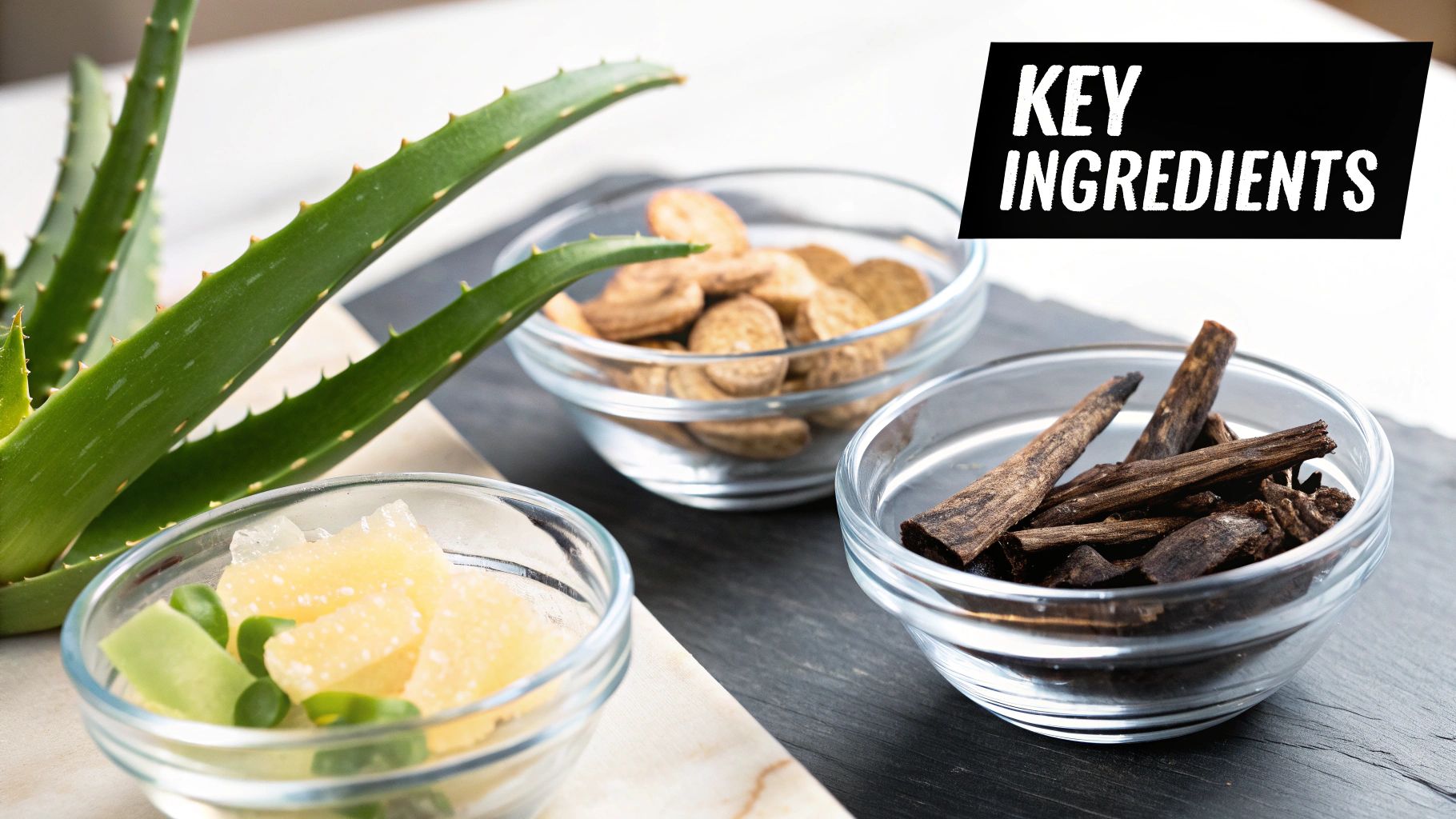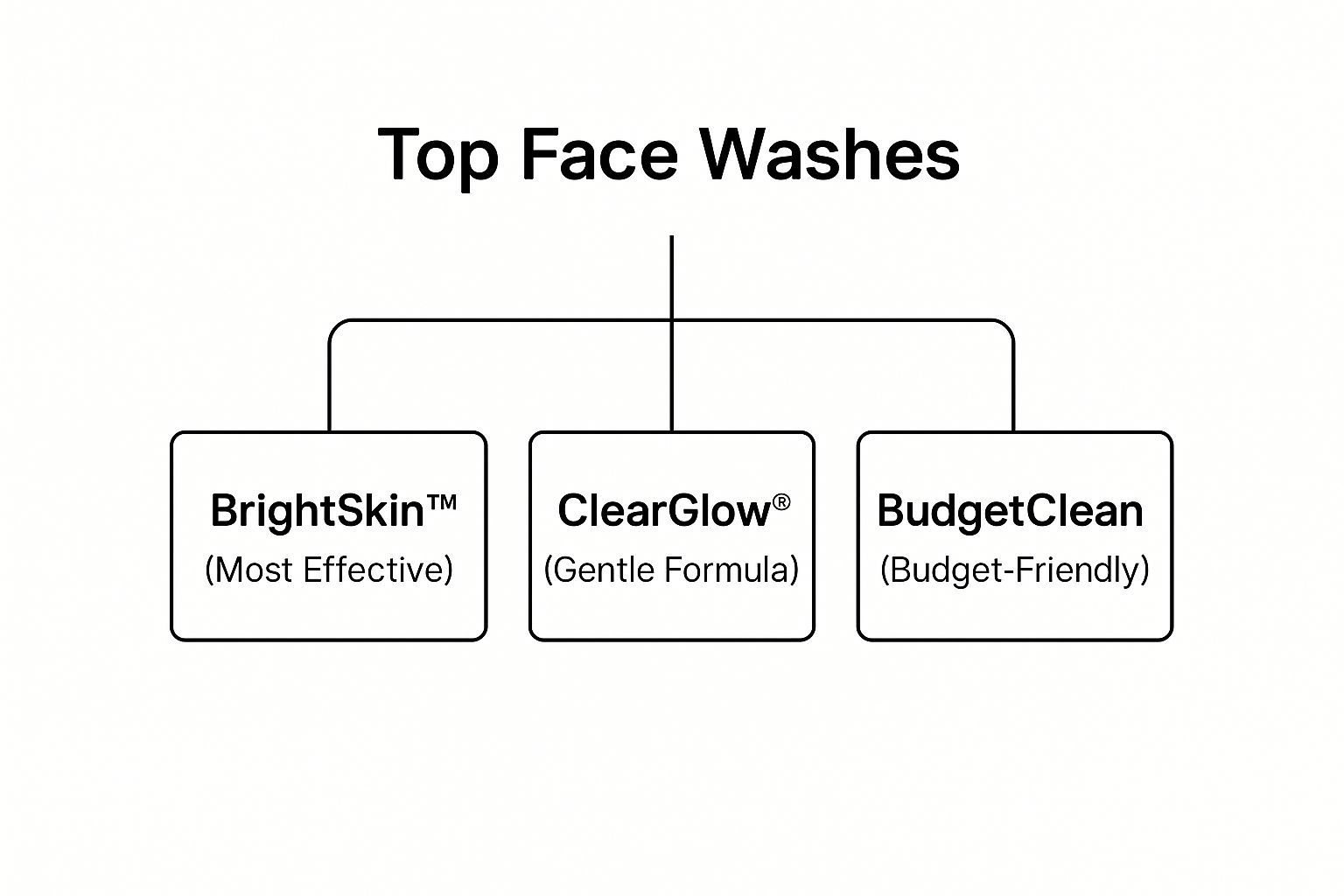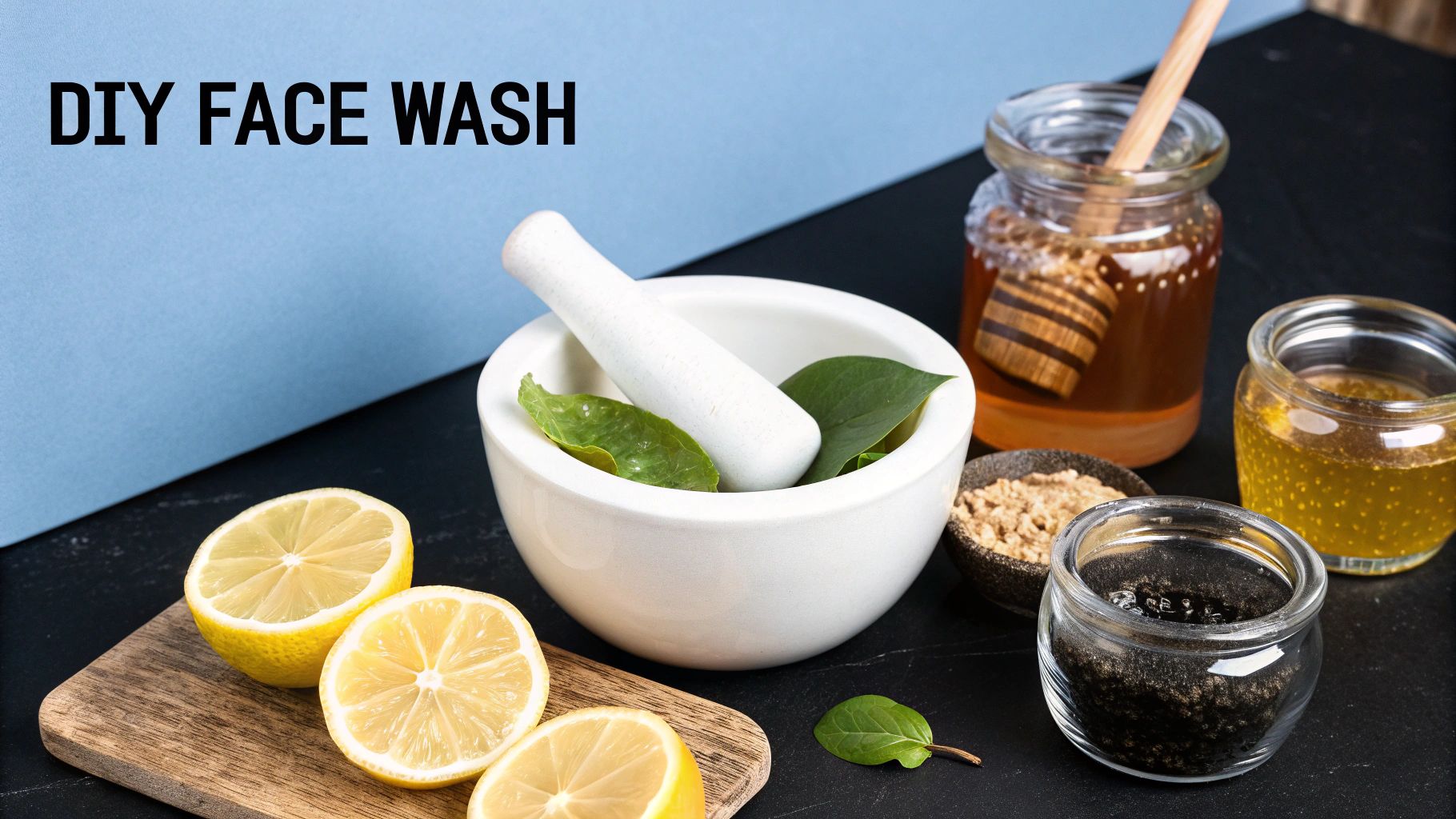On the hunt for the best face wash for dark spots in Canada? It’s all about the ingredients. The cleansers that truly make a difference are packed with proven brightening powerhouses like Vitamin C, Glycolic Acid, or Niacinamide. These are your go-to actives for exfoliating, protecting, and evening out your skin tone.
Think of them as your first line of defense in the journey to a clearer, more radiant complexion.
A Quick Guide To Fading Dark Spots
Finding the right face wash is a game-changer, especially for mature skin tackling hyperpigmentation. A good cleanser does so much more than just wash away the day's grime. It actively preps your skin, creating a perfect canvas so it can soak up all the goodness from the treatments that follow, like serums and moisturizers.
It's no surprise that the demand for products like this is skyrocketing. The global face wash market was valued at a whopping USD 22.19 billion back in 2018 and has only continued to grow as more of us wise up to the impact of sun exposure and environmental stress on our skin.
For us in Canada, this boom means a ton of new options on the shelves, from international brands to homegrown favourites, which can feel a little overwhelming. Let's cut through the noise and get straight to what actually works for Canadian skin.
Top Dark Spot Fighting Ingredients at a Glance
So, how does a face wash actually fight dark spots? It comes down to active ingredients that tackle melanin (the pigment that causes the spots) and kickstart cell turnover to reveal fresher, brighter skin.
While a great cleanser is a fantastic starting point, for truly noticeable results, you’ll want to pair it with other targeted treatments. If you're looking to level up your routine, check out our insights on the best dark spot serum to really accelerate your progress.
Here’s a simple table to help you spot the heroes on any ingredient list and figure out which one is the best match for you.
| Ingredient | Primary Action | Best For Skin Types |
|---|---|---|
| Vitamin C | Acts as a powerful antioxidant, helping to block the creation of excess pigment. | Great for all skin types, but especially for dull or sun-damaged skin. |
| Glycolic Acid (AHA) | A chemical exfoliant that sloughs off dead surface cells, revealing the brighter, more even skin underneath. | A fantastic choice for normal, combination, and oily skin types. |
| Niacinamide | Calms inflammation and works by stopping pigment from transferring to your visible skin cells. | A true all-rounder that's gentle enough for all skin types, including sensitive and acne-prone skin. |
By keeping an eye out for these ingredients, you'll be well on your way to choosing a cleanser that doesn't just clean, but actively corrects and brightens your skin.
Why Dark Spots Appear in the First Place

Before you can pick the best face wash for dark spots, it helps to know what you’re up against. Those stubborn spots, technically called hyperpigmentation, aren't just random blemishes. They’re a sign that your skin has been working hard to protect itself.
Think of it this way: your skin has specialized cells called melanocytes. Their main job is to produce melanin, the pigment that determines your skin tone. Normally, they distribute this color evenly for a smooth, uniform complexion.
But when these cells sense trouble—like inflammation or sun damage—they go into defense mode. They start pumping out extra melanin and rush it to the site of the "injury." This concentrated cluster of pigment is what shows up on your skin's surface as a dark spot.
The Main Triggers for Overactive Pigment
So, what sends these pigment-producing cells into a panic? A few common culprits are behind most of the dark spots we see, particularly as our skin matures. These triggers are like alarm bells that tell your melanocytes to get to work, fast.
Figuring out what's causing your spots is key. It helps you prevent new ones from forming while you treat the ones you already have.
-
Sun Exposure: This is, without a doubt, the number one cause. Even on a cloudy Canadian day, UV radiation is a direct threat to your skin, and melanocytes produce more pigment to act as a tiny protective "umbrella" over your skin cells. Ever notice a few new freckles after a sunny long weekend? That's your skin's defense system in action.
-
Post-Inflammatory Hyperpigmentation (PIH): This is just the clinical term for that dark mark left behind after a pimple heals, a bug bites you, or you get a small scratch. The initial inflammation is a major trigger, leaving a stubborn spot long after the blemish itself is gone.
-
Hormonal Changes: Life events like menopause cause hormone levels to fluctuate, which can trigger a condition called melasma. This often looks like larger, patch-like areas of discoloration, usually on the cheeks, forehead, and above the lip.
"Understanding the root cause of your hyperpigmentation is the most critical step. It’s the difference between randomly trying products and strategically choosing ingredients that directly address your skin’s specific distress signals."
How Aging Affects Dark Spots
As we get older, our skin's internal machinery starts to slow down. Skin cell turnover isn't as quick as it used to be, which means those pigmented cells hang around on the surface for much longer. On top of that, years of Canadian sun exposure begin to add up, making existing dark spots look darker and new ones appear more frequently.
This is exactly why a consistent, targeted skincare routine becomes non-negotiable. The right face wash will help break up the pigment you can see, while a high-quality moisturizer will support your skin’s protective barrier.
For mature skin, pairing your cleanser with the best moisturizer for aging skin is a powerhouse combination. It keeps your skin hydrated, strong, and better able to repair itself. With this approach, you're not just fading spots—you're building healthier, more resilient skin for the long haul.
Decoding the Powerhouse Ingredients That Work
Walking down the skincare aisle at a Canadian drug store can feel overwhelming. With so many bottles promising a miracle, how do you know what actually works? To find the best face wash for dark spots, you need to become a label detective and look for the science-backed ingredients proven to get the job done. These are the true heroes that fade hyperpigmentation and bring back your skin's natural glow.
Think of Vitamin C as your skin's daily bodyguard. It’s a powerful antioxidant that defends your skin from the environmental stressors—like sun exposure and pollution—that kick those pigment-producing cells into overdrive. Just as importantly, it gets directly involved in melanin production, essentially telling those overactive cells to take a break and dial back the pigment.
Then you have Glycolic Acid, a superstar in the alpha-hydroxy acid (AHA) family. Picture it as a gentle but effective polisher for your skin. It works by dissolving the bonds holding old, discolored skin cells to the surface, allowing them to be rinsed away. This not only reveals the brighter, fresher skin underneath but also paves the way for your other skincare products to sink in and work better.
The Supporting Cast of Brightening Agents
While Vitamin C and Glycolic Acid often get top billing, a whole crew of other ingredients plays a vital role in tackling dark spots. Getting to know them will help you pick a cleanser that’s a perfect match for your skin.
Niacinamide, or Vitamin B3, is a wonderfully gentle multitasker. Its genius lies in its ability to intercept melanin before it reaches your skin's surface. By blocking this transfer, it helps prevent new dark spots from ever showing up, making it a fantastic ingredient for both treating current spots and preventing future ones.
Don’t overlook Kojic Acid and Azelaic Acid, either. They are both serious contenders in the fight against hyperpigmentation.
- Kojic Acid: This ingredient, which comes from fungi, works by inhibiting the specific enzyme your body needs to make melanin. It’s a popular and effective brightener you'll find in many formulas available in Canada.
- Azelaic Acid: Found in grains like barley and wheat, this acid pulls double duty. It calms inflammation while also slowing down melanin synthesis, making it especially good for those stubborn marks left behind by acne.
Ingredient Deep Dive for Dark Spot Correction
Let's get a bit more technical. Understanding not just what an ingredient is, but how it works and at what strength, is the key to choosing a truly effective product. This table breaks down the science behind the most common brightening agents.
| Ingredient | How It Works on Melanin | Ideal Concentration Range | Potential Side Effects |
|---|---|---|---|
| Vitamin C | An antioxidant that inhibits tyrosinase, the key enzyme in melanin production, and neutralizes free radicals from UV exposure. | 5% - 20% | High concentrations can cause stinging or irritation, especially on sensitive skin. |
| Glycolic Acid | An AHA that exfoliates the skin's surface, accelerating the shedding of pigmented cells and enhancing the penetration of other ingredients. | 3% - 10% | Can cause dryness, redness, and sun sensitivity. Always use with sunscreen. |
| Niacinamide | Inhibits the transfer of melanosomes (pigment packets) from melanocytes (pigment cells) to keratinocytes (skin cells). | 2% - 5% | Very well-tolerated, but high concentrations (>10%) can sometimes cause redness. |
| Kojic Acid | Blocks tyrosinase activity by chelating the copper ion essential for the enzyme's function. | 1% - 4% | Can be slightly unstable and may cause contact dermatitis in some individuals. |
| Azelaic Acid | Selectively inhibits tyrosinase in overactive melanocytes, making it great for post-inflammatory hyperpigmentation (PIH). | 5% - 20% | Can cause mild itching or burning initially. Prescription strength is typically >15%. |
Choosing a cleanser with one or more of these ingredients in the right concentration is a game-changer. It ensures the product isn't just washing your face but actively treating your concerns with every use.
Making Sense of the Market
You're not alone in searching for a solution. The global skin lightening market, which includes cleansers targeting dark spots, is expected to explode from USD 9.7 billion in 2023 to USD 16.0 billion by 2033. Cleansers are a popular choice because they combine two essential steps—cleansing and treating—into one, and Canadians are actively looking for these powerhouse ingredients.
Knowing these key ingredients turns you from a hopeful shopper into a savvy expert. When you can glance at a label and spot Vitamin C, Niacinamide, or Kojic Acid, you’re no longer relying on marketing hype. You're making a choice based on proven science.
This chart helps break down some top-rated face wash options by what they do best, giving you a quick visual guide to find your best fit.

As the breakdown shows, some products excel as all-around performers, while others are better suited for sensitive skin or tighter budgets. The most important thing is finding what works for you. Sometimes, the secret to incredible results is pairing a great cleanser with other targeted treatments. For instance, if your skin is on the drier side, learning about the best face serum for dry skin can help you build a complete, hydrating routine that amplifies your brightening efforts.
Picking the Right Cleanser for Your Skin Type
Knowing which ingredients work is a great start, but the real magic happens when you match the best face wash for dark spots to your specific skin. A cleanser loaded with amazing brighteners is worthless if it leaves your skin feeling tight, irritated, and stripped raw. What we're aiming for is that perfect balance—a formula that corrects discoloration while keeping your skin calm and happy.
Every Canadian's skin is different. What works wonders for someone else might be a total disaster for you. That’s why you can't just grab any old bottle off the shelf; you have to find the one that understands your skin's unique needs.
Oily and Acne-Prone Skin
If your skin is oily or you're constantly battling breakouts, you know the struggle is twofold. First, you have the pimples, and then you have the stubborn dark marks they leave behind as a parting gift. Your ideal cleanser has to be a master multitasker, capable of controlling oil and clearing out pores while gently fading that leftover hyperpigmentation.
This is where Salicylic Acid becomes your best friend. As an oil-soluble beta-hydroxy acid (BHA), it doesn't just sit on the surface. It dives deep into your pores to dissolve the grime and buildup that cause acne in the first place, stopping new dark spots before they even have a chance to form.
Modern formulas are smart about this, often combining salicylic acid with soothing brighteners like niacinamide. This creates a beautifully balanced product that clarifies your skin without sending it into a panic.
Dry and Sensitive Skin
For anyone with dry or sensitive skin, the number one rule is "do no harm." The wrong cleanser can easily trigger redness, stinging, and inflammation, which only makes matters worse, especially during harsh Canadian winters. Your goal is to find a gentle giant—a wash that brightens effectively without stripping away the precious moisture your skin barrier needs to stay healthy.
Look for formulas built around gentler exfoliants like Mandelic Acid or Lactic Acid. These alpha-hydroxy acids have a larger molecular structure than something like glycolic acid, which means they penetrate the skin more slowly and are far less likely to cause irritation. Polyhydroxy Acids (PHAs) are another fantastic, ultra-gentle choice.
The key for sensitive skin is to double down on hydration and soothing ingredients. A face wash that includes calming agents like centella asiatica or hydrating hyaluronic acid alongside its brightening actives will support your skin while it works on fading those spots.
Mature and Combination Skin
Mature and combination skin is the classic "a little bit of everything" scenario. You might have an oily T-zone, some dry patches on your cheeks, and an overall goal of getting that radiant, even-toned glow back. You need a cleanser that’s balanced enough to tackle dark spots without making your dry areas drier or your oily spots oilier.
Foaming cleansers can be a game-changer here. In fact, their popularity is exploding, with the market projected to hit an incredible USD 25 billion by 2033. Why? They deliver a deep, satisfying clean that still feels gentle, and many are now packed with powerful brightening agents that specifically target discoloration.
An antioxidant-rich cleanser, especially one with Vitamin C, is an outstanding choice. It helps shield your skin from environmental stressors that speed up aging while also putting the brakes on melanin production. When you follow that up with the right makeup, you can create a truly seamless look. To complete your routine, check out our guide on finding the best foundation for mature skin.
Building a Routine to Maximize Your Results

Finding the right face wash is a brilliant start, but it's just that—a start. To get the kind of results that make you do a double-take in the mirror, you need a complete routine where every single product works in harmony.
Think of your new face wash as the warm-up act. It gets your skin perfectly prepped and ready for the headliners: your potent serums, nourishing moisturizers, and all-important sunscreen. When everything works together, you're not just cleansing; you're actively treating, protecting, and transforming your skin around the clock. This synergy is the secret to fading dark spots faster and for good.
The 60-Second Cleansing Rule
Here's one of the simplest, most effective tricks in the book: change how long you wash your face. Most of us do a quick 15-second scrub and rinse. Instead, try gently massaging your cleanser onto damp skin for a full 60 seconds.
That one minute makes all the difference. It gives those powerhouse ingredients like Vitamin C or Glycolic Acid enough time to actually sink in and get to work on that stubborn pigmentation. It’s a tiny tweak that elevates a simple wash into a targeted treatment.
Think of it this way: that extra time allows the active ingredients to move past the surface and start breaking down the melanin clusters that form dark spots. You're turning a routine chore into a results-driven step.
Once your minute is up, rinse completely with lukewarm water—never hot!—and gently pat your skin dry with a clean, soft towel. Be kind to your skin. Rubbing and pulling can cause irritation, which can trigger inflammation and even lead to more spots.
Your Post-Cleanse Power Trio
What you do in the moments right after you cleanse is absolutely crucial. Your skin is clean, damp, and perfectly primed to drink up whatever you apply next. This is your golden window of opportunity to layer on targeted treatments and lock in hydration.
Here are the three steps that should always follow your cleanse:
-
Treat with a Serum: This is where you bring in the big guns. A concentrated dark spot correcting serum delivers a high-potency dose of brightening ingredients straight to the source. It picks up right where your cleanser left off, supercharging your results.
-
Hydrate with a Moisturizer: Never, ever skip moisturizer. It’s not just about feeling soft; it’s about rebuilding your skin’s protective barrier, sealing in moisture, and locking in the serum you just applied. A healthy, hydrated skin barrier is your best defense against irritation and is far more efficient at repairing itself. For more tips, check out our guide to picking a daily facial moisturizer.
-
Protect with Sunscreen: I can't stress this enough: this is the most critical step in your morning routine. Sun exposure is the number one cause of dark spots, and skipping sunscreen is like trying to bail out a boat with a hole in it—you’ll just undo all your progress. A broad-spectrum sunscreen with at least SPF 30 every single day, rain or shine, is non-negotiable for anyone in Canada.
This three-step follow-up ensures that each product enhances the one before it, creating a powerful, cumulative effect. In skincare, consistency is king. Stick with it every day, and you'll be well on your way to that clear, even-toned complexion you deserve.
Your Questions About Fading Dark Spots, Answered
Starting a new routine to tackle hyperpigmentation always brings up a few questions. As you get ready to use a face wash designed for dark spots, you're probably wondering about how long it takes, what you can mix, and what's really going on with your skin.
We've pulled together the most common questions we hear from Canadians just like you. Think of this as your quick-start guide to get clear, confident answers and set yourself up for success.
How Long Does It Actually Take to See a Difference?
When it comes to skincare, patience isn't just a virtue—it's a necessity. While a top-notch face wash gets to work right away by cleansing and prepping your skin, seeing those dark spots actually fade takes a bit of time.
Your skin naturally renews itself about every 28 days, a process that slows down as we get older. You'll likely notice an initial boost in brightness and a smoother texture within the first 4 to 6 weeks of consistent, daily use. For those deeper, more stubborn spots? Give it at least 2 to 3 months to see significant lightening. The real magic happens when you stick with it.
Can I Mix and Match Different Brightening Ingredients?
Absolutely, but you have to be smart about it. Layering active ingredients can fast-track your results, but the wrong combination can backfire and lead to redness and irritation.
A simple, effective strategy is to use antioxidants like Vitamin C in the morning to shield your skin from daily damage. Then, use exfoliants like Glycolic Acid or your retinoid at night to focus on repair and renewal while you sleep. Niacinamide is wonderfully versatile and plays nicely with almost everything, helping to soothe skin and strengthen its protective barrier.
The golden rule? Introduce new ingredients one by one. Give your skin a week or two to adapt before adding something else. This way, you'll know exactly what's working and what might be causing a reaction.
Will My Dark Spots Come Back?
They can, unfortunately. Hyperpigmentation can be a persistent issue, especially if the original trigger—usually the sun—isn't kept in check. I like to compare it to weeding a garden; once the hard work is done, you still need to perform regular maintenance to keep things clear.
This is precisely why wearing sunscreen every single day is completely non-negotiable. It's your number one defense against old spots darkening again and new ones from ever showing up. Combining that daily SPF with your brightening face wash is the key to maintaining that even, glowing complexion you've worked so hard for.
Ready to get started on your path to brighter, more radiant skin? At PriPedi, we specialize in creating skincare that understands the unique needs of mature skin. Find the perfect products to help you glow.


